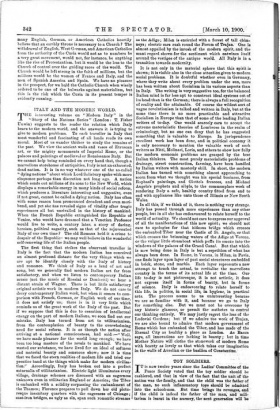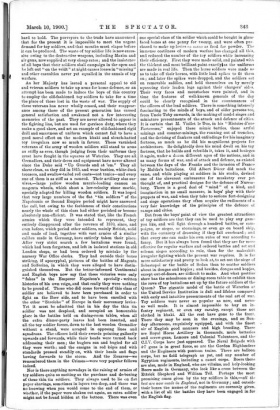TOY SOLDIERS.
IT is now twelve years since the Ladies' Committee of the Peace Society voted that the toy soldier should be cashiered, and that in view of the fact that the unit of the nation was the family, and that the child was the father of the man, no such inflammatory toys should be admitted into the schoolroom. But tune brings its revenges, and if the child is indeed the father of the man, and mili- tarism is learnt in the nursery, the next generation will be
hard to hold. The purveyors to the trade have announced that for the present it is impossible to meet the urgent demand for toy soldiers, and that months must elapse before it can be produced. The waste of toy soldier life is now exces- sive owing to the destructive weapons, including Maxim and air guns, now supplied at very cheap rates ; and the insistence of all boys that their soldiers shall campaign in the open and be left out "on the veldt" at night causes losses in "missing" and other casualties never yet equalled in the annals of toy warfare.
As her Majesty has issued a personal appeal to old and veteran soldiers to take up arms for home defence, so an attempt has been made to induce the boys of this country to employ the old-fashioned toy soldiers to take for a time the place of those lost in the waste of war. The supply of these veterans has never wholly ceased, and their reappear- ance among those of the present generation has caused general satisfaction and awakened not a few interesting memories of the past. They are never allowed to appear in the fighting line, but are used for garrison duty, where they make a good show, and set an example of old-fashioned rigid drill and smartness of uniform which cannot fail to have a good moral effect on the modern khaki and slouch-hatted toy irregulars now so mach in favour. These varnished veterans of the army of wooden soldiers still stand to arms as stiffly as ever, though judging from their uniforms they must have fought in the squares at Waterloo. They are all Grenadiers, and their dress and equipment have never altered since the Duke said "Up Guards and at 'em." They all shave clean, as they did in 1815. and wear busbies, white-duck trousers, and swallow-tailed red coats—not tunics—and every one of them is as stiff as a ramrod. Their artillery also sur- vives,—large yellow wooden muzzle-loading cannon on magenta wheels, which shoot a low-velocity stone marble, specially adapted for killing wooden soldiers. It was hoped that very large numbers of the flat "tin soldiers" of the Napoleonic or Second Empire period might have answered the call, but owing to the feebleness of their constitutions nearly the whole of this class had either perished or become absolutely non-efficient. It was stated that, like the French armies which they were intended to represent, they entirely disappeared after the reverses of 1870, since, and even before, which period other soldiers, mainly British, solid and made of lead, together with vast armies of a similar calibre made in Germany, have entirely taken their place. After very strict search a few battalions were found, which had been forgotten, and left in isolated stations in old London shops, or had been ordered by mistake by the nursery War Office clerks. They had outside their boxes striking, if apocryphal, pictures of the battles of Magenta and Solferino, in which they were alleged to have distin- guished themselves. But the better-informed Continental and English boys now say that these victories were only "fakes" in the Emperor Napoleon's specially - written histories of his own reign, and that really they were nothing to be proud of. Those who did come forward of this class of soldier are believed to have been purchased in order to fight on the Boer side, and to have been enrolled with the other " Strolche " of Europe in their mercenary levies. Yet it must be admitted that in his day the thin tin soldier was not despised, and occupied an honourable place in the battles held on dining-room tables, when all the extra dinner-party leaves had been inserted, and all the toy soldier forces, down to the last wooden Grenadier without a stand, were arrayed in opposing lines and squadrons. The officers held their swords pointing gallantly upwards and forwards, while their heads were turned back addressing their men ; the buglers ran and bugled for all they were worth ; and the ensigns in red kepis and with standards pressed steadily on, with their heads and flags bowing forwards to the storm. And the Zouaves—we remembered them in the Crimea—were very popular fellows indeed.
Nor is there anything nowadays in the raising of armies of toy soldiers quite so exciting as the purchase and de-boxing of these thin tin soldiers. They always used to lie on flat paper shavings, sometimes in layers two deep, and there was no knowing when you would come to the end of them, or whether, if the paper were shaken out again, an extra soldier might not be found hidden at the bottom. There was even
one special class of tin soldier which could be bought in glass- faced boxes at one penny for twenty, and were often pur- chased to make up levies u hasse as food for powder. The immense costliness of modern warfare has changed all this, and reduced the number of the toy soldiers while increasing their efficiency. First they were made solid, and painted with the thickest and most brilliant paint exactlyI as the uniforms are made in real life. Then the horse soldiers were made so as to take off their horses, with little lead spikes to fit them on ; and later the spikes were dropped, and the soldiers sat on removable saddles, and held themselves on by merely squeezing their leaden legs against their chargers' sides. Their very faces and moustaches were painted, and in time the features of well-known generals of the day could be clearly recognised in the countenances of the officers of the lead soldiers. There is something intensely fascinating to the minds of boys, and of older persons too, from Uncle Toby onwards, in the making of model sieges and miniature presentments of the attack and defence of cities. It is certain that M. Viollet le Duc, in his " Histoire d'une Forteresse," enjoyed these mimic battles, these artful minings and counter-minings, the running out of trenches, and the devising of flankers and enfiladings for his imaginary fortress, as much as he did his magnificent projects for architecture. So delightedly does his mind dwell on his toy fortress, that he builds and rebuilds it, takes it, and besieges it again, under a dozen different ages of the nations, and in as many forms of war, and of attack and defence, as existed between the days of the Franks and the invasion of France by Moltke's battalions. Old Albert Diirer did much the same, and while playing at soldiers in his studio, devised one of the cleverest embrasures for musketry ever yet thought of, and practical designs for the defence of Nurem- berg. There is a good deal of " mind " of a kind, and imagination in no small measure, in boys' play with their puppets of war, and when they take to serious fort-designing and siege operations they often acquire the rudiments of a very fair knowledge of the principles of the defence of camps and cities.
But from the boys' point of view the greatest attractions of toy soldiers are that they can be used to play any game you like, and will fight through a hundred battles, or cam- paigns, or sieges, or atormings, or even go on board ship, with the certainty of drowning if they fall overboard ; and that every one can make his own rules of war according to fancy. But it has always been found that they are far more effective for regular warfare and ordered battles and set and solemn sieges according to rule, than for the makeshift irregular fighting which the present war requires. It is far more satisfactory and pretty to look at, to set out the siege of Sebastopol or the battle of Sedan than to scatter soldiers about in dongas and kopjes ; and besides, dongas and kopjes, except out-of-doors, are difficult to make. And what prettier show has the schoolroom or dining-room table to exhibit than the rows of toy battalions set up by the future soldiers of the Queen? The gigantic model of the battle of Waterloo at the United Service Institution is dull and lifeless compared with early and intuitive presentments of the real art of war. Toy soldiers were never so popular as now, and never so well made. It is almost impossible to buy an in- fantry regiment, or even any cavalry, except those not clothed in khaki. All the rest have gone to the front. There they may be seen in the evenings, and on Sun- day afternoons, exquisitely equipped, and with the finest air of English good manners and high breeding. There are Royal Horse Artillery in thousands, mule batteries and screw-grins, Lancers and Colonial Volunteers, and the C.I.V. Corps have just appeared. The Naval Brigade with 4.7 guns is in great force, so are the Gordon Highlanders and the Engineers with pontoon trains. There are balloon corps, but no field telegraph as yet, and any number of Egyptian regiments, including a camel corps. Boers there are also, made in England, who are villains, and holy-looking Boers made in Germany, who look like a cross between the Ettrick Shepherd and William Tell. Perhaps the most promising omen given by the toy soldiers is this,—all thP best are now 9nade in England, not in Germany ; and outside their boxes the names of the regiments are correctly given, with a list of all the battles they have been engaged in for the English flag.







































 Previous page
Previous page